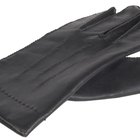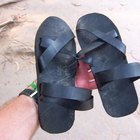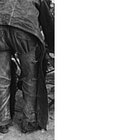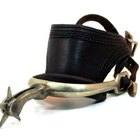When you decide to make a pair of chaps, you should keep in mind what purpose they are going to serve. If they are only supposed to keep away minor irritants, then practically any tough cloth will suffice. However, for chaps meant to protect against snakes, you must keep not only the type of cloth but also the design of the chaps themselves in mind.
Fit
When creating a pair of homemade snake-proof chaps, keep in mind that snakes can get into very small places. Therefore, snake-proof chaps should close completely over the legs to encase them. If possible, grommets should be punched into the chaps so they can be laced up tightly, leaving no opening or exposed skin below the crotch area. Additionally, snake-proof chaps should fit snugly. Lastly, snake-proof chaps should have drawstrings around the ankles to prevent snakes from slithering up into the chaps or into the wearer's pants underneath.
Material
If you intend for your pair of homemade chaps to protect you against snakebites, then you must carefully consider the material they will be made of. Thin denim or other materials that are easily pierced should not be considered for snake-proof chaps. Leather—rawhide if possible—is one of the best materials to make snake-proof chaps from because of its toughness and difficulty to pierce. Denim may also be an option, but you should be careful about making this choice, because denim is not as durable as leather. Heavy-grade material, such as Kevlar or Cordura nylon, is another option, but most people will not have the ability to sew those materials together themselves. Test several materials with a thick needle or other simulation of a snake's fang before choosing one. If you have trouble piercing the material, than it is likely a good one to use.
Layers
When you construct a set of homemade snake-proof chaps, consider making them in layers. The outer and inner layers should be made of the same material, ideally either rawhide or very tough denim (or, once again, Kevlar or Cordura nylon if you can sew it). Insert a layer of your second-choice material between the outer and inner layers. For instance, if you used denim to make the outer and inner layers, place a layer of rawhide between the two. If rawhide is what was used for the inner and outer layers, then place a layer of denim between the two. The layering creates additional barriers that snakes have to bite through, thus providing extra protection for the wearer.
Related Articles

Characteristics of Lambskin Leather

How to Fix Ripped Leather Gloves

How to Make a Pair of Ho Chi Minh ...

How to Make Homemade Shoes

What Type of Shoes Should Be Worn for ...

How to Remove Studs & Rivets From Jeans

How to Make Custom Chaps

How to Shrink Flannels

How to Make Moccasins Out of Deer Skin

How to Make a Snake Skin Belt

How to Sandpaper Jeans

How to Put on Padded Bike Shorts

How to Turn Boxer Briefs Into Briefs

How to Make Cowboy Spurs

How to Make a Bolero Jacket

How to Hand Sew a Tear in Pants

How to Keep Your Pant Legs in Your Boots

How to Keep the Elastic in a Waistband ...

How to Cook Chicken Kebabs in a Bottom ...

How to Rip Jeans at the Bottom
Writer Bio
Neal Litherland is an author, blogger and occasional ghostwriter. His experience includes comics, role playing games and a variety of other projects as well. He holds a bachelor's degree in criminal justice from Indiana University, and resides in Northwest Indiana.